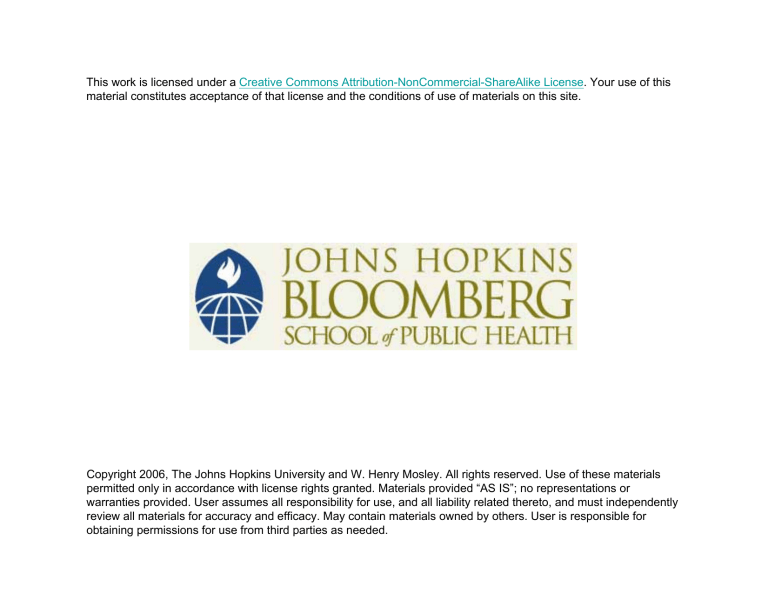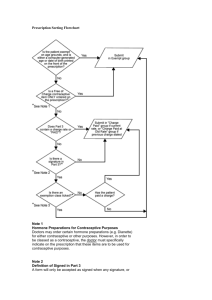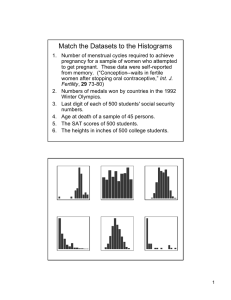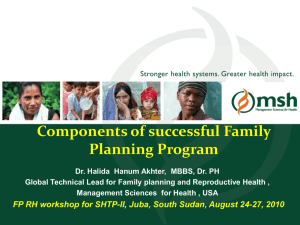licensed under a . Your use of this Creative Commons Attribution-NonCommercial-ShareAlike License

This work is licensed under a Creative Commons Attribution-NonCommercial-ShareAlike License . Your use of this material constitutes acceptance of that license and the conditions of use of materials on this site.
Copyright 2006, The Johns Hopkins University and W. Henry Mosley. All rights reserved. Use of these materials permitted only in accordance with license rights granted. Materials provided “AS IS”; no representations or warranties provided. User assumes all responsibility for use, and all liability related thereto, and must independently review all materials for accuracy and efficacy. May contain materials owned by others. User is responsible for obtaining permissions for use from third parties as needed.
PFHS 380.665 FAMILY PLANNING POLICIES AND PROGRAMS
Case Studies – Users Perspectives, Quality of Care, Medical Barriers and
Contraceptive Choices
W. Henry Mosley
Much has been learned about the development and implementation of family planning programs over the past four decades since the first national programs were first introduced. Many of these lessons have been integrated into the concept of Quality of Care (by Judith Bruce and others). A related issue concerns unnecessary “medical barriers” to contraceptive that has been well summarized by Shelton and others (1992).
RamaRao and Mohanam (2003) provide a recent review of the considerable body of research on “quality” in family planning programs, looking at the multiplicity of strategies to study the effects of improvements in various elements of provider performance on various programmatic outcomes, and identifying the many questions that remain unanswered. A recent synthesis of many of these lessons into an overall programmatic strategy for new contraceptive introduction has been developed by the international donor community and is summarized in the article “A Strategic Approach to
Contraceptive Introduction” by Simmons, et al. (1997). Some of the key points are summarized below.
A. Quality in Family Planning Programs - Sending a Message to the Client
1. Six elements of quality (Bruce, 1990) a. Choice of methods b. Information given to clients c. Technical competence of providers d. Interpersonal relations e. Mechanisms to encourage continuity f. Appropriate constellation of services
2. Attributes of high quality programs (Jain, Bruce, and Mensch,
1992) a. Providers offer an appropriate choice of methods to all clients. b. Providers do not promote or restrict unnecessarily any particular method. c. Providers are technically competent in screening clients for contraindications. d. Providers are competent in supplying clinical methods and are able to apply effective, aseptic techniques. e. Clients receive information on method options, as well as information on contraindications, common side effects, follow-up requirements, and duration of effectiveness of the method selected.
f. Providers solicit information about clients' background, reproductive goals, attitudes, prior experience with contraceptives, and preferences to assist clients' choice process. g. Clients receive information on the possibility of switching methods or source of supply. h. Clients make a specific appointment for a follow-up visit or a i. specific plan for re-supply with providers.
Clients are afforded privacy for examinations, information sharing, j. and personal interviews.
Providers treat clients with dignity and respect.
B. Legal and Medical Barriers to Family Planning
1. Reproductive rights/women's status - do laws, regulations or practices facilitate or impede women's/couples' autonomy and rights to "determine the number and spacing of their children" and access to the means to achieve this?
•
marriage
•
abortion
•
coercive incentives or disincentives regarding childbearing
2. Delivery of family planning services and technologies - do laws/regulations unnecessarily impede the promotion or delivery of contraceptive methods and services?
•
import restrictions/tariffs on contraceptives
•
restrictions on specific methods
•
restrictions on advertising/promotion
•
restrictions on over-the-counter sales
•
restrictions on provider qualifications
•
barriers to private (for profit) sector service provision
3. Medical standards of practice - regulations/restrictions/protocols
•
limitations on method by age, parity, marital status
•
excessive tests, exams, screening protocols, follow-up schedules
• limitations on what categories of personnel can perform specific procedure
C. Case Studies
The case studies given here were selected from a vast literature to give some recent practical illustrations of problems and issues that still confront family planning service delivery programs in different countries, and how these are identified, analyzed, interpreted and, in some cases resolved. You are encouraged to read all of the case
studies, however, for the class purposes, each group is required to read only two cases and present these to the class.
Required Readings for Class Discussion
(See last page for Group assignments for the discussion )
Diaz M, Simmons R, Diaz J, Gonzalez C, Makuch MY, and Bossemeyer D.
Expanding contraceptive choice: findings from Brazil. Studies in Family
Planning 30 (1): 1-16, 1999
Goldberg HI, Toros A. The use of traditional methods of contraception among
Turkish couples. Studies in Family Planning 25(2):122-128, March/April
1994.
Rajaretnam T, and Deshpande RV. Factors inhibiting the use of reversible contraceptive methods in rural South India. Studies in Family Planning 25(2):
111-121, 1994.
Saavala M. Understanding the prevalence of female sterilization in rural South India.
Studies in Family Planning 30(4): 288-301, 1999.
Schuler, SR, Choque, ME, and Rance, S. Misinformation, mistrust, and mistreatment: family planning among Bolivian market women. Studies in Family Planning
25(4): 211-221, 1994.
Solo, J, Billings, C A-O, Ominde, A, and Makumi, M. Creating linkages between incomplete abortion treatment and family planning services in Kenya. Studies
in Family Planning 30(1): 17-27, 1999.
Speizer IS, Htochkiss DR, Magnani RJ, Hubbard B, Nelson K. Do service providers in Tanzania unnecessarily restrict clients’ access to contraceptive methods? International Family Planning Perspectives 26(1):
13-20. 2000.
Tuoane, ‘M, Madise, NJ, and Diamond, I. Provision of family planning services in
Lesotho. International Family Planning Perspectives 30(2): 77-86, 2004.
Reference resources:
Simmons, R, Brown, J, Diaz, M. Facilitating large scale transitions to quality of care: an idea whose time has come. Studies in Family Planning 33: 61-75. 2002.
RamaRao, S and Mohanam, R. The quality of family planning programs: concepts, measurements, interventions and effects. Studies in Family Planning 34(4):
227-248, 2003.
Recommended Readings:
Askew I, Mensch B, Adewayi A. Indicators for measuring quality of family planning services in Nigeria. Studies in Family Planning 25 :268-283, 1994.
Brown L, Tyane M, Bertrand J, Lauro D, Abou-ouakil M, deMaria L. Quality of care in family planning services in Morocco. Studies in Family Planning 26(3): 154-168,
1995.
Bruce J. Fundamental elements of the quality of care: a simple framework. Studies in
Family Planning 21 (2):61-91, 1990.
Casterline, JB, Sathar, ZA, ul Haque, M. Obstacles to contraceptive use in Pakistan: a study in Punjab. Studies in Family Planning 32: 95-110, 2002.
Cooperating Agencies Task Force on Informed Choice - Executive Summary. Informed
Choice. July 1989..
Dixon-Mueller R. The sexuality connection in reproductive health. Studies in Family
Planning 24 (5):269-282, September/October 1993.
Fisher AA, de Silva V. Satisfied IUD acceptors as family planning motivators in Sri
Lanka. Studies in Family Planning 17 (5):235-242, September/October, 1986..
Hardee K, Clyde M, McDonald OP, Bailey W., Villinski M. Assessing family planning service delivery practices: The case of private physicians in Jamaica. Studies in
Family Planning 26 (6): 338-349, 1995.
Hollerbach P. The impact of national policies on the acceptance of sterilization in
Colombia and Costa Rica. Studies in Family Planning 20 :308-325, 1989.
Huntington D, Lettenmaier C, Obeng-Quaidoo I. User's perspective of counseling training in Ghana: the "mystery client" trial. Studies in Family Planning 21 (3):171-177,
May/June 1990.
Huntington D, Schuler SR. The simulated client method: evaluating client-provider interactions in family planning clinics. Studies in Family Planning 24 (3):187-193,
May/June 1993.
Jain AK. Fertility reduction and the quality of family planning services. Studies in
Family Planning 20 (1):1-16 January/February, 1989.
Jain A, Bruce J, Mensch B. Setting standards of quality in family planning programs.
Studies in Family Planning 23 (6):392-395, November/December 1992.
Kols AJ, Sherman JE. Family Planning Programs: Improving Quality. Population
Reports: Series J, No. 48, Baltimore, Johns Hopkins University School of Public
Health, Population Information Program, October, 1998.
Kaufman J, Zhirong Z, Xinjian Q, Yang Z. The quality of family planning services in rural China. Studies in Family Planning 23 (2):73-84, March/April 1992.
Keeney, GM. Assessing Legal and Regulatory Reform in Family Planning: Manual on
Legal and Regulatory Reform. Policy Paper Series No. 1. OPTIONS II, The Future
Group, Washington, D.C., January 1993
Kim Y-M, Rimon J, Winnard K, Corso C, Mako IV, Lawal S, Babalola S, Huntington D.
Improving the quality of service delivery in Nigeria. Studies in Family Planning
23 (2):118-127, March/April 1992.
Koenig MA, Foo GHC, Joshi K. Quality of care within the Indian Family Welfare
Programme: a review of recent evidence. Studies in Family Planning 31 (1): 1-
18, 2000.
Lassner KJ, Janowitz B, Rodrigues CMB. Sterilization approval and follow-through in
Brazil. Studies in Family Planning 17 (4):188-198, July/August 1986.
Lettenmaier C, Gallen ME. Why counseling counts! Population Reports , Series J, No.
36, December 1987. Population Information Program, Center for Communication
Programs, Johns Hopkins University, Baltimore, MD 21202.
Loaiza E. Sterilization regret in the Dominican Republic: looking for quality-of-care issues. Studies in Family Planning. 26(1): 39-48, 1995.
Pariani S, Heer DM, Van Arsdol MD. Does choice make a difference to contraceptive use? Evidence from East Java. Studies in Family Planning 22 (6):384-390,
November/December 1991.
Shelton JD, Angle MA, Jacobstein, RA. Medical barriers to access to planning. (8831): 1334-5 1992.
Shelton, JD. The provider perspective: human after all. International Family Planning
Perspectives 27: 152-53, 161, 2001.
Simmons R, Baqee L, Koenig MA, Phillips JF. Beyond supply: the importance of female family planning workers in rural Bangladesh. Studies in Family Planning 19 (1): 29-
38, 1988.
Simmons R, Fajans P, Lubis F. Contraceptive introduction and the management of choice: The role of Cylcofem in Indonesia. Contraception 49 : 509-525, 1994.
Simmons R, Hall P, Diaz J, Diaz M, Fajans P, Satia J. The strategic approach to contraceptive introduction. Studies in Family Planning 28 (2):79-94, 1997
Stanback, J, and Twum-Baah, KA. Why do family planning providers restrict access to services? An examination in Ghana. International Family Planning Perspectives
27: 37-41,2001.
Trottier DA, Potter LS, Taylor BA, and Glover LH. User characteristics and oral contraceptive compliance in Egypt. Studies in Family Planning 25(5): 284-292,
1994.
Tuladhar J, Donaldson P, and Noble J. The introduction and use of Norplant implants in
Indonesia. Studies in Family Planning 29 (3): 291-299, 1998.
Tucker GM. Barriers to modern contraceptive use in Peru. Studies in Family Planning
17 :308-316, 1986.
Vera H. The client's view of high-quality care in Santiago, Chile. Studies in Family
Planning 24 (1): 40-49, 1993.
D. Class Discussion Assignments
Two articles are assigned to each group. All members of a group should be familiar with both assigned articles for the purposes of leading the class discussion.
Group 1 – Articles: Diaz, et al., 1999; Speizer, et al., 2000.
Group 2 – Articles: Goldberg, et al., 1994; Schuler, et al., 1994.
Group 3 - Articles: Rajaretnam, et al., 1994; Solo, et al., 1999.
Group 4 - Articles: Saavala, et al., 1999; Tuoane, et al., 2004
Points for discussion:
Why: Why was this research done - what was the rationale for this study? Why was this considered to be an important problem?
How: How was the study carried out? Were original data collected, was this a secondary analysis of existing data, or was this a critical/analytical review of published work? If original data were collected, was there an experimental design, or was this an observational study/record review? Do you detect any biases in the study design, the data collections or analysis, or the conclusions that lead you to question the findings? If so, what are they?
What: What were the questions and issues being addressed? What were the main
(empirical) findings and conclusions of the study? Are they fully supported by the data given? Were there unanswered questions and directions for future research?
So What: Will the findings make any difference in family planning policies and programs in the country and/or internationally? Why, or why not?





